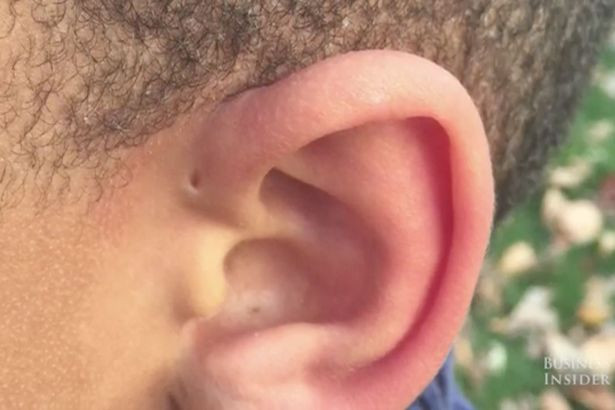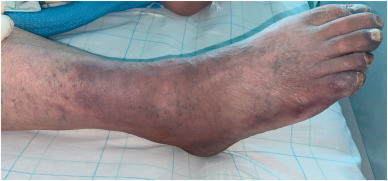Definisi
Fistula preaurikular (preauricular pit) adalah lubang kecil di depan telinga. Lubang ini terlihat seperti bekas tusukan atau bekas pemasangan anting. Fistula preaurikular terjadi pada sekitar 5-10 anak dari 1000 kelahiran. Berdasarkan American Academy of Family Physicians (AAFP), sekitar 1% bayi memiliki lubang fistula preaurikular sedangkan di Afrika sekitar 10% bayi memiliki kondisi ini.
Lubang kecil ini merupakan saluran sempit di bawah kulit yang tidak berbahaya, walaupun terkadang lubang bisa terinfeksi. Ukuran dari lubang ini bervariasi dan biasanya lubang muncul di depan satu telinga.
Penyebab
Fistula preaurikular terjadi akibat adanya gangguan saat proses pembentukan telinga, terjadi pada minggu keenam dari perkembangan janin. Para ahli berpendapat bahwa fistula preaurikular disebabkan oleh kondisi genetik yang diturunkan. Jika kedua telinga memiliki fistula preaurikular, hal ini dapat menunjukkan adanya kemungkinan kelainan bawaan pada keluarga.
Walaupun jarang terjadi, fistula preaurikular dapat muncul sebagai tanda dari beberapa sindrom kelainan bawaan dan bisa berhubungan dengan sindrom genetik, seperti:
1. Sindrom Branchio-oto-renal (BOR)
Sindrom yang berhubungan dengan kelainan jaringan leher, gangguan pembentukan telinga, gangguan pendengaran, serta kelainan pembentukan dari ginjal. Sindrom ini muncul sebagai mutasi dari gen EYA1, SIX1, atau SIX5.
2. Sindrom Beckwith-Wiedemann
Sindrom yang memengaruhi beragam bagian tubuh, dimana tubuh dan organ menjadi lebih besar. Terdiri atas pembesaran tubuh dan lidah, organ bisa keluar dari pusar (omfalokel), kanker pada ginjal, dan kanker pada liver. Pasien dengan sindrom ini juga dapat memiliki lubang telinga yang tidak simetris.
3. Mandibulofacial dysostosis
Kelainan pada wajah, kepala yang sangat kecil dan tidak tumbuh seperti batang tubuh yang lain, turut disertai dengan gangguan perkembangan, gangguan bicara dan bahasa, serta disabilitas intelektual. Sindrom ini juga sering disebut sebagai Treacher Collins syndrome.
Dokter anak yang memeriksa bayi baru lahir akan mengonsultasikan anak dengan fistula atau lubang preaurikular ke dokter spesialis THT (Telinga, Hidung, dan Tenggorokan) untuk dilakukan pemeriksaan lebih lanjut.
Pada kondisi dimana fistula preaurikular terinfeksi, mikroba yang paling sering menyebabkan infeksi adalah bakteri Staphylococcus aureus, diikuti oleh bakteri Proteus sp., Streptococcus sp., dan Peptococcus sp.
Faktor Risiko
Risiko yang meningkatkan anak mengalami fistula preaurikular adalah ibu yang mengonsumsi obat hipertiroid (kondisi ketika kelenjar tiroid terlalu banyak menghasilkan hormon tiroid ) yaitu propylothiuracil (PTU) selama kehamilan. Konsumsi obat ini di awal kehamilan untuk mengatasi hipertiroid diasosiasikan dengan kelahiran anak dengan penyakit bawaan lahir pada area wajah dan leher, walaupun hal ini masih memerlukan penelitian lebih lanjut.
Gejala
Gejala dari fistula preaurikular umumnya hanya berupa lubang di sisi depan telinga. Lubang biasanya berada di depan salah satu telinga, walaupun ada juga kasus dimana lubang ditemukan di depan dua telinga. Meskipun fistula preaurikular seharusnya tidak ada dan digolongkan sebagai kelainan bawaan, fistula preaurikular tidak berbahaya, kecuali bila fistula disertai dengan sindrom genetik.
Walaupun tidak berbahaya, fistula preaurikular dapat terinfeksi. Gejala infeksi pada fistula preaurikular yang dapat muncul antara lain:
- Pembengkakan di sekitar lubang depan telinga
- Lubang mengeluarkan cairan atau nanah
- Kemerahan pada lubang
- Demam
- Nyeri di area lubang
Banyak orang yang tidak menyadari mereka memiliki fistula preaurikular. Sekitar 25% orang dewasa yang memiliki fistula preaurikular mengalami gejala infeksi berupa keluarnya cairan dari lubang tersebut.
Diagnosis
Bila kondisi ini ditemukan pada bayi dan anak-anak, dokter akan mewawancara orang tua anak terkait keluhan yang dirasakan, bagaimana riwayat kehamilan ibu, serta riwayat penyakit dalam keluarga. Dokter akan mencari tahu bila kelainan fistula ini berdiri sendiri atau disertai dengan sindrom genetik lain. Untuk itu, dokter akan melakukan pemeriksaan fisik pada kepala, telinga, dan leher anak.
Bila diperlukan, dokter dapat melakukan pemeriksaan pencitraan seperti CT scan atau MRI dengan kontras. Pemeriksaan pencitraan ini dapat membantu tenaga kesehatan melihat kondisi lain seperti kista atau infeksi. Pada anak yang dicurigai memiliki sindrom genetik, Tenaga kesehatan bisa menyarankan untuk melakukan pemeriksaan genetik. Dalam kondisi ditemukannya sindrom genetik pada anak, pemeriksaan penunjang yang selanjutnya dilakukan akan disesuaikan dengan sindrom tersebut.
Tata Laksana
Fistula preaurikular biasanya tidak berbahaya dan tidak memerlukan terapi. Meskipun lubang ini tidak akan menutup sendirinya, bila fistula tidak menimbulkan keluhan maka tidak perlu dilakukan prosedur operasi untuk menutup lubang.
Antibiotik
Pada kondisi ketika fistula mengalami infeksi bakteri, dokter akan memberikan antibiotik untuk menghentikan pertumbuhan bakteri. Antibiotik yang diberikan dokter harus dihabiskan untuk mengurangi kemungkinan resistensi atau kekebalan bakteri terhadap antibiotik.
Prosedur bedah
Jika fistula preaurikular terus mengalami infeksi berulang sampai terbentuk abses atau kantung yang berisi nanah, bisa dilakukan prosedur insisi dan drainase, prosedur pengeluaran nanah yang terkumpul dalam kantung. Dokter juga bisa menyarankan untuk melakukan prosedur bedah untuk menutup lubang dan mengangkat saluran yang terhubung pada lubang tersebut di bawah kulit.
Setelah prosedur operasi, dokter akan memberikan obat-obatan pereda nyeri dan jadwal kontrol. Dokter akan menginformasikan pasien terkait manajemen nyeri dan perawatan luka yang baik untuk mencegah terjadinya infeksi di kemudian hari.
Terapi pada anak dengan sindrom genetik
Pada sebagian besar kasus, anak dengan fistula preaurikular sehat dan memiliki kehidupan biasa. Beberapa orang dengan sindrom BOR dapat memiliki masalah ginjal, namun dengan pengobatan yang baik gagal ginjal dapat dicegah dan pasien dapat hidup normal.
Pada beberapa kasus anak dengan sindrom Beckwith-Wiedemann mengalami risiko kematian dan komplikasi lainnya. Namun, terdapat kasus di mana anak dengan sindrom Beckwith-Wiedemann hidup normal dan produktif.
Dengan pengobatan yang baik, seseorang dengan mandibulofacial dysotosis dapat memiliki kecerdasan normal dan ekspektasi usia yang normal.
Perawatan fistula
Fistula preaurikular perlu dibersihkan setiap hari dengan menggunakan sabun dan air. Tidak ada cara tertentu untuk membersihkan lubang tersebut. Jika Anda mengalami infeksi pada fistula preaurikular, selain meminum obat yang diresepkan oleh dokter, Anda dapat melakukan hal-hal di bawah ini:
- Mengonsumsi obat pereda nyeri
- Mengompres telinga dengan kain hangat
- Membersihkan area telinga
- Hindari menyentuh telinga
Komplikasi
Komplikasi dari fistula preaurikular adalah:
1. Infeksi
Gejala infeksi pada fistula preaurikular adalah demam, nyeri, kemerahan, bengkak dan keluarnya nanah. Jika tidak ditangani, hal ini dapat menyebabkan abses dan selulitis.
2. Kista
Pada daerah lubang preaurikular dapat muncul benjolan yang tidak nyeri, disebut juga sebagai kista. Hal ini dapat meningkatkan risiko infeksi pada fistula preaurikular.
Pencegahan
Kondisi ini tidak dapat dicegah, namun Anda dapat mencegah infeksi pada fistula preaurikular dengan membersihkan lubang ini secara berkala. Anda juga perlu memeriksakan kondisi ini ke dokter jika terdapat nanah atau cairan yang keluar dari lubang. Menunda pengobatan infeksi dapat menyebabkan komplikasi lebih lanjut, seperti abses.
Kapan Harus ke Dokter?
Seseorang dengan dua lubang preaurikular perlu memeriksakan diri ke dokter THT. Dokter dapat melakukan pemeriksaan lanjutan untuk memeriksa kondisi lainnya yang berhubungan dengan lubang preaurikular. Anda juga perlu memeriksakan fistula preaurikular ke dokter jika mengalami infeksi berulang, infeksi yang tidak merespon terhadap antibiotik atau pengobatan, dan jika Anda mengalami pembengkakan atau benjolan pada telinga.
Mau cari tahu seputar penyakit telinga, hidung, tenggorokan lainnya? Cek di sini, ya!
- dr Hanifa Rahma
Karp, M. (2021). What are preauricular pits?. Verywellhealth. Available from: https://www.verywellhealth.com/what-is-that-hole-near-my-childs-ear-1048873
Marcin, J. (2018). What is this small hole in front of my child's ear? Healthline. Available from: https://www.healthline.com/health/hole-in-ear
Ratini, M. (2021). What is a preauricular pit?. WebMd. Available from: https://www.webmd.com/skin-problems-and-treatments/what-is-preauricular-pit
Ostrower, ST. (2020). Preauricular cysts, pits, and fissure. Medscape. Available from: https://emedicine.medscape.com/article/845288-overview
Wilson, DR. (2019). What is a preauricular pit? MedicalNewsToday. Available from: https://www.medicalnewstoday.com/articles/327106












